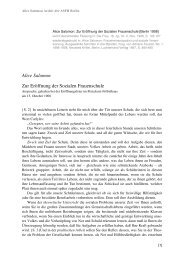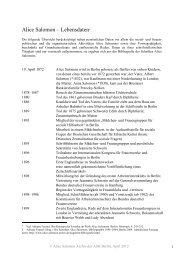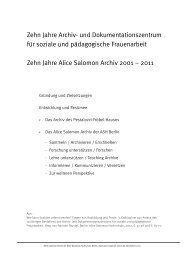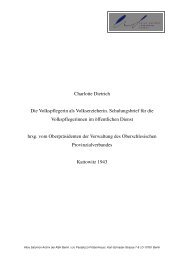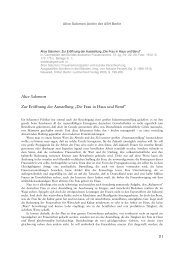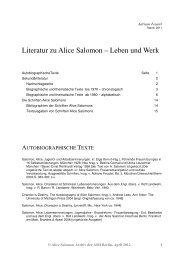Teaching Gender in Social Work - MailChimp
Teaching Gender in Social Work - MailChimp
Teaching Gender in Social Work - MailChimp
Create successful ePaper yourself
Turn your PDF publications into a flip-book with our unique Google optimized e-Paper software.
the families? Who would visit regularly homes <strong>in</strong> rural areas and research the<br />
family situation? Who was prepared to undertake such work <strong>in</strong> villages?<br />
In 1927 the Child Protection Union <strong>in</strong> Bulgaria began a year’s course<br />
for female teachers, prepar<strong>in</strong>g them to work as volunteers, especially <strong>in</strong> the<br />
villages. Usually the participants <strong>in</strong> these courses were young female teachers<br />
from local village schools. Dur<strong>in</strong>g the course the female teachers covered various<br />
discipl<strong>in</strong>es – school hygiene, the symptoms and treatment of tuberculosis, the<br />
symptoms of malaria, <strong>in</strong>fant mortality, eugenics, children’s rights, the anatomy<br />
and physiology of the female body, child tooth care, sport and tourism. A textbook<br />
especially for them was produced. 16<br />
The courses were meant to pass on elementary medical knowledge. The<br />
female teachers visited child hospitals and other child <strong>in</strong>stitutions <strong>in</strong> order to<br />
become acqua<strong>in</strong>ted with exist<strong>in</strong>g practices and hygiene standards. More than a<br />
thousand teachers were tra<strong>in</strong>ed over the next ten years. 17<br />
In the villages the female teachers’ advisors were supposed to visit homes<br />
and collect data about the liv<strong>in</strong>g conditions of families and children; to spread<br />
hygiene and health knowledge among young girls, mothers and children; to<br />
organise hygiene soup kitchens for school children; and to decrease the <strong>in</strong>fluence<br />
of the old untra<strong>in</strong>ed midwifes who tended to defended traditional practices of<br />
child rear<strong>in</strong>g. Annual reports for all these activities were required by the central<br />
body of the Child Protection Union, some of which were published <strong>in</strong> its<br />
newspaper. The teachers visited families <strong>in</strong> order to observe liv<strong>in</strong>g conditions,<br />
hygiene and nutrition. They asked pupils about their breakfast habits and <strong>in</strong>structed<br />
young mothers and girls. They had also to shave the hair of children<br />
to prevent the spread of typhus. In many villages they cooked for the children<br />
<strong>in</strong> soup kitchens.<br />
The vice-president of the Bulgarian Child Protection Union, Konstanza<br />
Ljapcheva, recommended that female teachers and advisors develop a strong will,<br />
self-discipl<strong>in</strong>e, personal order and cleanl<strong>in</strong>ess, as well as a planned schedule of<br />
work to be done <strong>in</strong> the poorest villages. Only <strong>in</strong> this way, would a female teacher<br />
and advisor be able to ga<strong>in</strong> the trust of villagers, to fulfil her tasks of teach<strong>in</strong>g<br />
children and mothers and of open<strong>in</strong>g soup kitchens for poor children.<br />
16<br />
Penka Georgieva – Petkova and Todor Zubov, Rakovodstvo za uchitelki-savetnichki (Guidebook for female<br />
teachers and advisors), (Sofia, 1933).<br />
17<br />
There were 5712 elementary schools <strong>in</strong> the villages of Bulgaria <strong>in</strong> the 1930s. See Konstantsa Ljapcheva, “Zakrila<br />
na selskoto dete v Balgaria” (Protection of the peasant child <strong>in</strong> Bulgaria), Nasheto dete, (1942): 9-10.<br />
136



